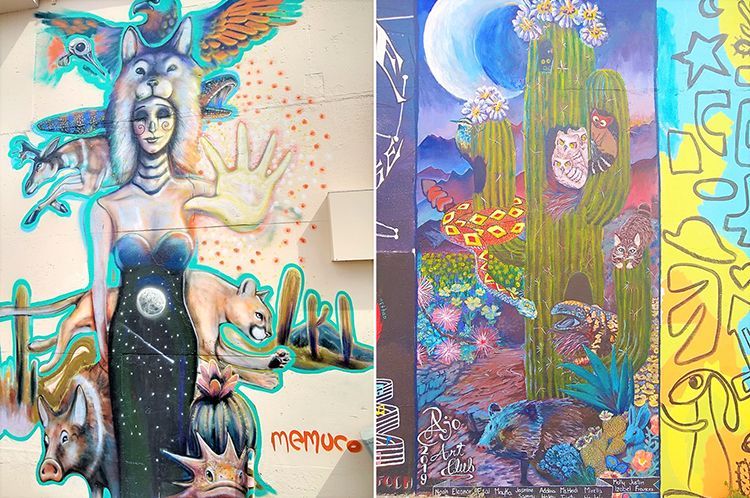The International Sonoran Desert Alliance (ISDA) received Section 4 grant to help focus on telling the story of resiliency in their surrounding Native communities, Mexican Town and Indian Village, in Ajo, Arizona. ISDA has been working in the Sonaran desert for over 20 years. Once a mining town, Ajo Arizona had a history of institutional segregation and historic trauma, followed by displacement, due to the destruction and evictions that followed the shuttering of mining operations.
The grant funding supported a series of artist engagements, designed to explore and highlight the history of the built environment in Ajo’s historic town center through the lens of Native American and Latinx youth.
Artists, design professionals and skilled tradespeople worked together to transform previously dead spaces into a rich tapestry of public art dedicated to a resilient community.
Rebuilding a Resilient Community
Since its inception in 1993, the organization has focused on building resilient communities. Starting out as a predominantly environmental and cultural preservation organization, ISDA developed community needs and desires and priorities which moved them into a more comprehensive community economic development organization.
The first major project was the Curly School project, which is now 30 units of affordable live-in working housing for artists and artisans. Through this project, a series of murals were created and designed by Native American and Latinx youth that explore environmental and cultural preservation concerns. The goal of this project was to build on decades of creative placemaking work defining renewed purpose for and bringing life back to abandoned spaces while creating a renewed since of community ownership among Native American and Latinx youth.

A series of interpretive installations became a part of a comprehensive signage and way-finding process that began in the fall of 2019. Allowing the tenants, who are the artists, to be their own drivers in this creative placemaking space, consisted of a lot of creative reuse and redevelopment of historic structures where art and culture lead the way. By using art to help repurpose those buildings became a part of reclaiming and energizing of once dead space through the installation of public art to help share memories of those lost spaces.
Energy is now returning to once dead spaces, including the opening of a new coffee shop, a PRIDE Center and a Youth Substance Abuse Awareness office on the historic Curley School campus, due in large part to reclaiming once dead space through the installation of public art.
Motivated by this project, the art teacher at the local high school district implemented a curriculum about the critical role that youth play in resilient communities. Students were challenged to envision and explore pathways to success that could either be pursued locally or, with a tertiary education credential, allowing for future artists to return to re-invest in their own community.
This project supported and expanded relationships among ISDA, the local school district, programs for disconnected youth and regional arts organizations. It was determined that the once abandoned structures held shared memory and it became extremely important to this community, so ISDA worked with a lot of communities throughout the Sonoran Desert, saving these places of memory.
“Saving memories was at the top of their list because a lot of structures were on the fast track to the wrecking ball and were going to eventually be lost forever. And so, that's really where they said this is important to us. Can you help us navigate and find a way to save these buildings”, says Aaron Cooper, Executive Director.
International Sonoran Desert Alliance also provides access to many critically important services including: paying utility bills, help signing up for Supplemental Nutrition Assistance Program and Arizona Health Care Cost Containment System benefits, and more recently, offering rental assistance.
